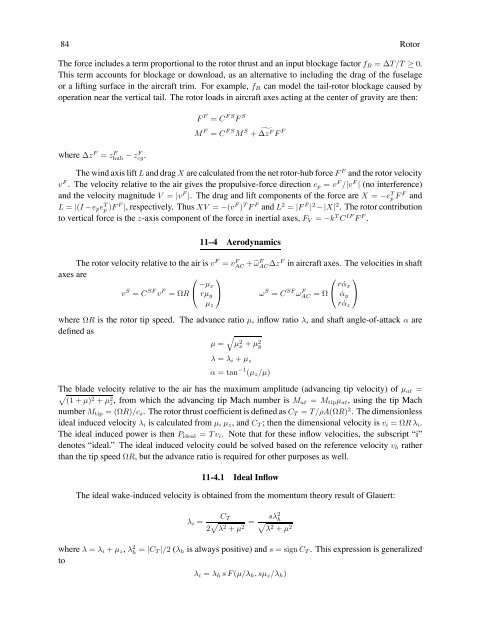Download - NASA
Download - NASA
Download - NASA
Create successful ePaper yourself
Turn your PDF publications into a flip-book with our unique Google optimized e-Paper software.
84 Rotor<br />
The force includes a term proportional to the rotor thrust and an input blockage factor fB =ΔT/T ≥ 0.<br />
This term accounts for blockage or download, as an alternative to including the drag of the fuselage<br />
or a lifting surface in the aircraft trim. For example, fB can model the tail-rotor blockage caused by<br />
operation near the vertical tail. The rotor loads in aircraft axes acting at the center of gravity are then:<br />
where Δz F = z F hub − zF cg.<br />
F F = C FS F S<br />
M F = C FS M S + Δz F F F<br />
The wind axis lift L and drag X are calculated from the net rotor-hub force F F and the rotor velocity<br />
v F . The velocity relative to the air gives the propulsive-force direction ep = v F /|v F | (no interference)<br />
and the velocity magnitude V = |v F |. The drag and lift components of the force are X = −e T p F F and<br />
L = |(I −epe T p )F F |, respectively. Thus XV = −(v F ) T F F and L 2 = |F F | 2 −|X| 2 . The rotor contribution<br />
to vertical force is the z-axis component of the force in inertial axes, FV = −k T C IF F F .<br />
11–4 Aerodynamics<br />
The rotor velocity relative to the air is vF = vF AC + ωF ACΔzF in aircraft axes. The velocities in shaft<br />
axes are<br />
v S = C SF v F ⎛<br />
=ΩR⎝<br />
−μx<br />
⎞<br />
rμy ⎠<br />
μz<br />
ω S = C SF ω F ⎛ ⎞<br />
r ˙αx<br />
AC =Ω⎝<br />
˙αy ⎠<br />
r ˙αz<br />
where ΩR is the rotor tip speed. The advance ratio μ, inflowratio λ, and shaft angle-of-attack α are<br />
defined as<br />
μ =<br />
<br />
μ 2 x + μ 2 y<br />
λ = λi + μz<br />
α = tan −1 (μz/μ)<br />
The blade velocity relative to the air has the maximum amplitude (advancing tip velocity) of μat =<br />
(1 + μ) 2 + μ 2 z, from which the advancing tip Mach number is Mat = Mtipμat, using the tip Mach<br />
number Mtip =(ΩR)/cs. The rotor thrust coefficient is defined as CT = T/ρA(ΩR) 2 . The dimensionless<br />
ideal induced velocity λi is calculated from μ, μz, and CT ; then the dimensional velocity is vi =ΩRλi.<br />
The ideal induced power is then Pideal = Tvi. Note that for these inflow velocities, the subscript “i”<br />
denotes “ideal.” The ideal induced velocity could be solved based on the reference velocity vh rather<br />
than the tip speed ΩR, but the advance ratio is required for other purposes as well.<br />
11-4.1 Ideal Inflow<br />
The ideal wake-induced velocity is obtained from the momentum theory result of Glauert:<br />
λi =<br />
CT<br />
2 λ2 sλ<br />
=<br />
+ μ2 2 h <br />
λ2 + μ2 where λ = λi + μz, λ 2 h = |CT |/2 (λh is always positive) and s = sign CT . This expression is generalized<br />
to<br />
λi = λh sF(μ/λh,sμz/λh)
















